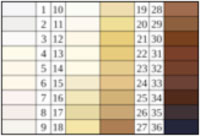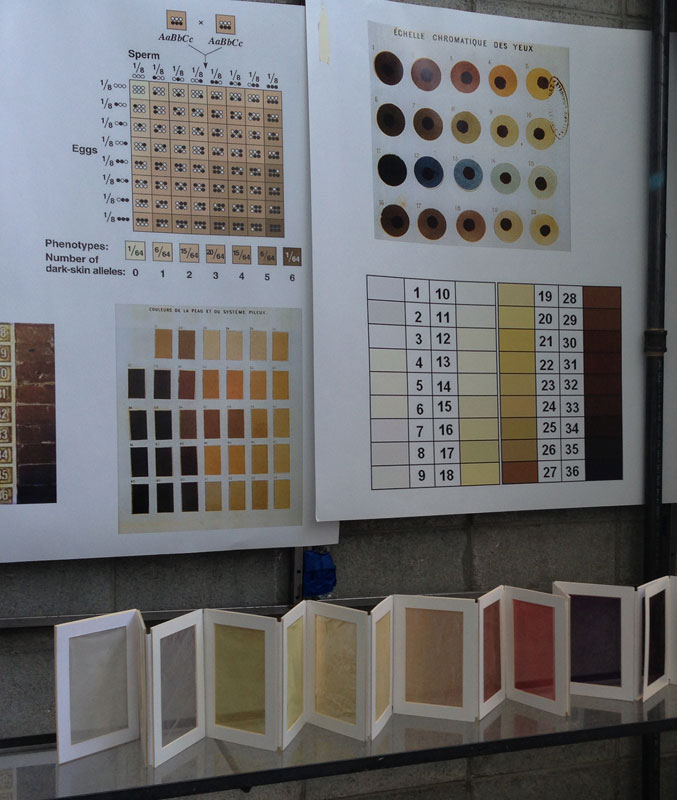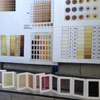Twisted Data
Catalog (PDF)
Press
http://www.haberarts.com/tag/twisted-data/
http://www.craveonline.com/art/929611-secret- histories-twisted- data
Works in Exhibition
SHADES OF WHITE (BOOK), 2015
Silk and Book Board 4” x 5” closed, 6’open.
Artist Statement
Shades of White was an installation created for the Artist Project Space at the Jordan Schnitzer Museum of Art. The work represents the “Gates Skin Color Chart,” a tool used by geneticists and anthropologists in the mid-20th century for racial classification. It is based on the research of Dr. Alexandra Minna Stern, a medical historian at the University of Michigan. Stern researches the history of eugenics and its attendant genetic and racial discrimination as practiced in the United States from 1900-87. This project exposes the genetic discrimination at play in the United States beginning in 1900 and links it to the practice of eugenics aimed at achieving racial hygiene in Nazi Germany. As Stern points out in Eugenic Nation, the top eugenicists in the U.S. collaborated with and followed the same practices as their Nazi counterparts in 1930s Germany. In fact, the “Gates Skin Color Chart” is based on a similar chart dating to 1905 created by Felix von Luschan, which the German Society for Racial Hygiene utilized in selecting the victims of the forced sterilizations performed in that country.
Felix von Luschan's Chromatic Scale (pictured below) was used to establish racial classifications of populations according to skin color. Named for its inventor, Felix von Luschan, the equipment consisted of thirty-six opaque glass tiles that were compared to the subject's [skin color?]

Preface-twisted Data
The latest exhibition curated by Maddy Rosenberg, Twisted Data, opens in Haber Space at CENTRAL BOOKING on November 19 and runs through January 24th. Misinterpretation of scientific findings seems to be a dangerous enough practice, but the prevalence of beliefs in pseudo-sciences can have an even more devastating effect when they “prove” cultural prejudices. We may laugh at phrenology and its simplification of physiognomy, but at one time it was a serious segment of the “science” of criminology. Perhaps more toxic and lasting is eugenics, embraced by those in every place of power, specifically in this country and in Britain - and used by the Nazis as a basis for their own horrific campaign against those they deemed “unfit.” The dissemination of misinformation laid the groundwork both for a justification for such “cleansing” on a grand scale and for continued wrongheaded discourse and policies in the Western world. It pervaded the laws and the culture – and created myths of immigrants that remain difficult to dispel to this day.
Noah Fuller and John Kuo Wei Tchen excavate and expose the archives of the once formidable Eugenics Record Office in Cold Spring Harbor--damage that keeps on damaging. Patricia Olynyk sorts through documentation in her own way to make art from the record. The films of Todd Herman manage to find a visual beauty celebrating the victims of atrocities perpetrated upon those deemed to be subpar. Rosary Solimanto utilizes her own experiences as the perceived inferior, twisting a position as a guinea pig into one of empowerment through art. Brandstifter searches old German medical texts and literally turns them on their heads, while Charley Friedman’s anatomy lesson is based on “unseemly” variations. Melissa Stern’s “creatures,” too, inhabit a world avoiding ethnic cleansing in order to exist, and Bram Harris delves into the limitations of ethnic identification through a specific genetic code. Barbara Rosenthal attempts to find answers in the simplicity of the alternative through historical diagrams. Jeffrey Allen Price maps the brain according to the color-coded quadrants of phrenology, while the colors that Geraldine Ondrizek map are only skin deep. Sarah Stengle wryly combines angels of all colors with the detritus of spent bullets and bones, peacefulness only to be found in heaven, it seems.
Through art we attempt to understand the unfathomable: how human beings can categorize, degrade, and experiment on each other, under a pseudo-scientific cover in a culturally relative quest for “perfecting” the human race.



